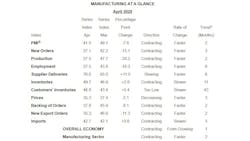ISM: After 131 months of expansion, economy contracts in April
Economic activity in the manufacturing sector contracted in April, and the overall economy contracted after 131 consecutive months of expansion, say the nation’s supply executives in the latest Manufacturing ISM Report On Business.
“Comments from the panel were strongly negative (three negative comments for every one positive comment) regarding the near-term outlook, with sentiment clearly impacted by the coronavirus (COVID-19) pandemic and continuing energy market recession,” said Timothy R Fiore, chair of the ISM Business Survey. “The PMI indicates a level of manufacturing-sector contraction not seen since April 2009, with a strongly negative trajectory.
“Demand contracted heavily, with the New Orders Index contracting at a very strong level, again pushed by new export order contraction, Customers’ Inventories Index approaching a level that is considered a negative for future production, and Backlog of Orders Index strongly contracting, in spite of a lack of production during the period.
“Consumption (measured by the Production and Employment indexes) contributed negatively (a combined 36.5-percentage point decrease) to the PMI calculation, with activity dramatically contracting due to plant closures and lack of demand.”
The April PMI registered 41.5%, down 7.6 percentage points from the March reading of 49.1%.
Other highlights from the report:
- The New Orders Index registered 27.1%, compared to the March reading of 42.2%.
- The Production Index registered 27.5%, compared to the March reading of 47.7%.
- The Backlog of Orders Index registered 37.8%, compared to the March reading of 45.9%.
- The Employment Index registered 27.5%, compared to the March reading of 43.8%.
- The Supplier Deliveries Index registered 76%, compared to the March reading of 65%, limiting the decrease in the composite PMI.
- The Inventories Index registered 49.7%; compared to the March reading of 46.9%.
- The Prices Index registered 35.3%, compared to the March reading of 37.4%.
- The New Export Orders Index registered 35.3%, compared to the March reading of 46.6%.
- The Imports Index registered 42.7%, compared to the March reading of 42.1%.
“Inputs—expressed as supplier deliveries, inventories and imports—strengthened again due to supplier delivery issues that were partially offset by continuing imports sluggishness,” Fiore said. “The delivery issues were the result of disruptions in domestic and global supply chains, driven primarily by supplier plant shutdowns. Inventory contraction slowed due to throughput issues. Inputs contributed positively (a combined 13.8-percentage point increase) to the PMI calculation. (The Supplier Deliveries and Inventories indexes directly factor into the PMI; the Imports Index does not.) Prices continued to contract (and at a faster rate in April), supporting a negative outlook.”
Transportation equipment, fabricated metal products, machinery, miscellaneous manufacturing and primary metals were among 15 industries reporting contraction in April. Only two of the 18 manufacturing industries reported growth (paper products and food, beverage and tobacco products).
“The coronavirus pandemic and global energy market weakness continue to impact all manufacturing sectors for the second straight month,” Fiore concluded. “Among the six big industry sectors, food, beverage and tobacco products remains the strongest.
“Transportation equipment and fabricated metal products are the weakest of the big six sectors.”
Here are some selected comments from respondents:
- “30% decrease for April due to COVID-19 impact on both customers and suppliers.” (Computer & Electronic Products)
- “Production stopped, other than to make hand sanitizer for those in need.” (Chemical Products)
- “COVID-19 has created a wave of activities, including vendors closing, vendors focusing only on the medical industry, employees not coming to work, delayed shipments from overseas, etc.” (Transportation Equipment)
- “The food processing B2B space remains steady. We are weathering the storm. There is a fortunate increased need for packaged foods. Softening is showing through in some products that find their way into food service and lodging.” (Food, Beverage & Tobacco Products)
- “Our refinery is losing money making gasoline due to the falling demand.” (Petroleum & Coal Products)
- “We supply the construction industry in various ways, where the slowdown has been a bit slower than most industries. It is, however; beginning to impact our business, and we see more challenges on the horizon.” (Fabricated Metal Products)
- “The company I work for manufactures personal protective equipment [PPE], specifically N95 masks, face shields, as well as selling protective clothing and hand protection. In the area of PPE, our backlog has spiked to numbers we have never seen. While no doubt some of the backorders will be canceled, many of the orders are longer term commitments from [the] US government.” (Apparel, Leather & Allied Products)
- “Our packaging business is starting to see signs of a slowdown in May after two strong months into COVID-19.” (Paper Products)
- “COVID-19 has destroyed our market and our company. Without a full recovery very soon, and some assistance, I fear for our ability to continue operations.” (Nonmetallic Mineral Products)
- “Dealing with the effects of coronavirus and having 65% of our operations down.” (Furniture & Related Products)

